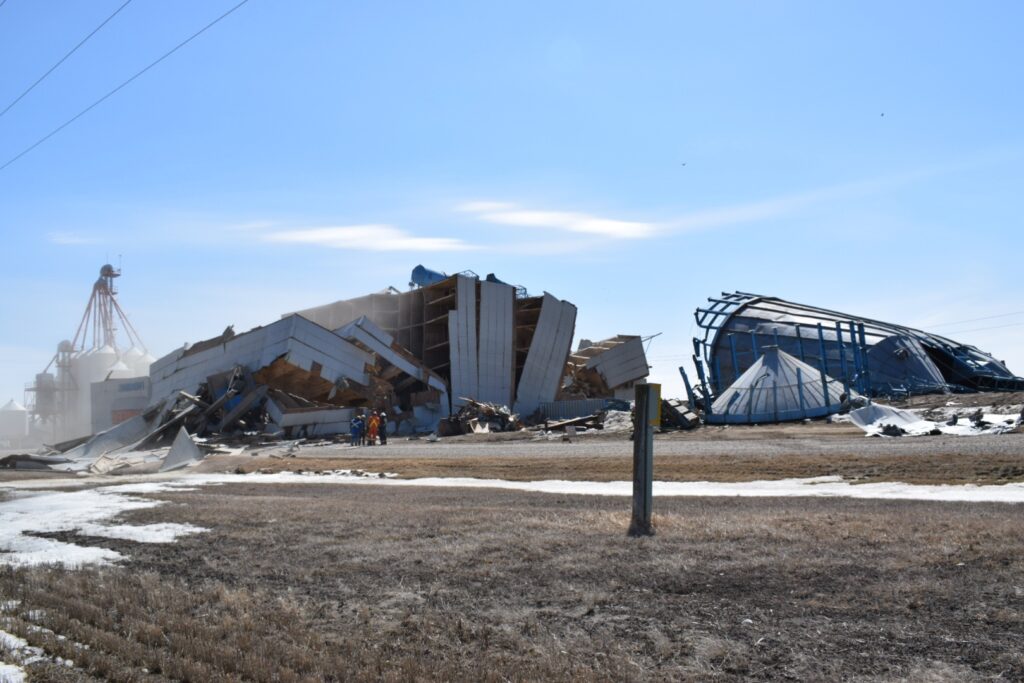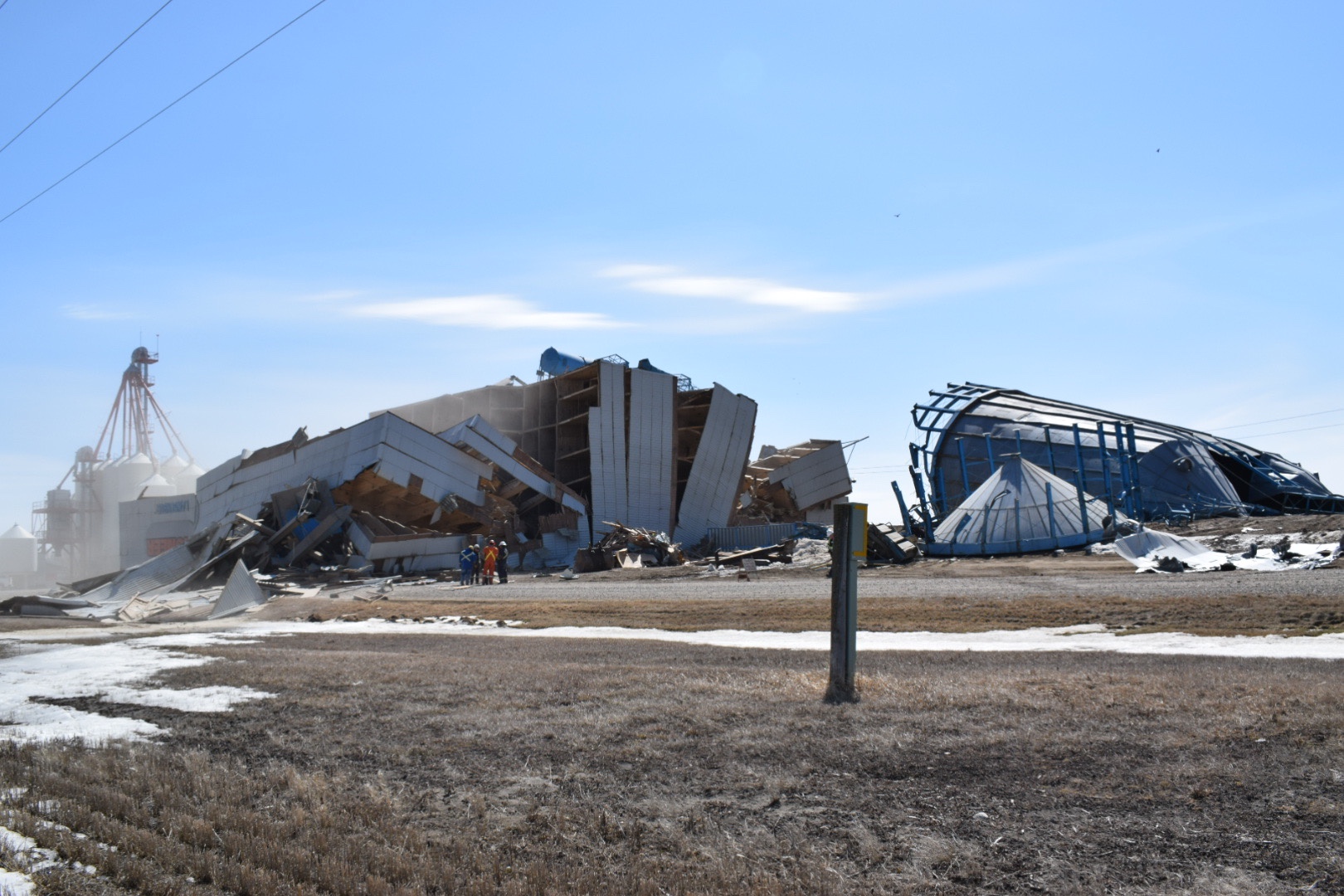United Grain Growers, Agricore and Viterra history inter-wound alongside Richardson Pioneer.
A memorable landmark is no longer standing as one drives into Langenburg heading eastward.
The Pioneer grain-handling elevator that recently came down may not exist anymore, but its history will live on with thanks to input from locals to gather its story.
According to the Langenburg history book Our Heritage, “When the original elevators were built in Langenburg it was important that they be in the centre of town – near the livery barn, the stores, the bank and possibly the saloon. In 1987 it [was] more important to be out of town – to allow more car spotting capacity, to avoid traffic congestions and to remove pollution…It is a tribute to the patience and loyalty of Langenburg Local Board and customers.”
At that time, Sask Wheat Pool and United Grain Growers had their elevators right in Langenburg.
The UGG elevator was right across the tracks from where Wallins Grocery currently sits.
The Need for a New Facility
When talk arose in 1985 to rebuild the facility, the need for more track space was identified. The official grand opening for the new United Grain Growers elevator was held on the outskirts of the town on Wednesday, June 24, 1987.
Ron Schultz was an active board member and advocate of UGG Langenburg, serving as a local board chairman from 1982-85.
Ron, along with his father Ray Schultz would travel with a small local group to go to Winnipeg to talk with the head office of UGG (and later, Agricore United). The pair would often be joined by local UGG committee members like Tom Werle who was the secretary of the local UGG board from 1974-86.
These meetings would give a broader perspective of what influenced the market and the global outlook on agriculture.
“They gave the opportunity to participate as a local farmer in the larger company structure; that was always appreciated by local farmers, when they have a say with what is going on in a bigger world.”
One thing that sticks out to the local board members is how the representatives would often go to Winnipeg to discuss the need for a new elevator. Kelvin Wiebe worked with the UGG committee for a number of years. He said the group “discussed the local operations, how much grain was going through the facility, the growing need for a bigger plant.” The thing he emphasized was the need to keep talking to head office. He talked about how at the local committee meetings, there was always a UGG representative in attendance. The various levels of the company were well connected and the head office directors were often farmers as well and wanted to talk to the locals directly.
These trips seemed to pay off. UGG decided in 1987 to build a new elevator at the location where it was recently taken down.
The Last Wooden Elevator
It was the last wooden elevator built by UGG. At that time, concrete elevators were beginning to pop up around the countryside.
Kelvin Wiebe said, “We were asking the question at that time why they wouldn’t build it with concrete. When we were going to build our elevator, UGG had just put a wooden one up in Yellowgrass that burned down before it was finished.”
UGG said that it was still cheaper to build the wooden crib so that was the direction the company went.
Speaking about the larger outlook of the grain industry, Ron Schultz said, “The grain industry went through major changes since the 1980s.
Talking about UGG when the elevator was built in 1987, Ron said. “The board of directors were all farmers at that time as it was still a cooperative process. The United Grain Growers and the Pool were all cooperatives. The dilemma they started running into was raising capital for their expansion phase that was coming up through the 1980s until 2015, and even now.”
When deciding on the process to build the facility, costs were an important consideration.
Changing Corporate Structures
Schultz said, “In the local area we were always productive and had good crop production. At that point in time, the grain handling facility could handle one million to four million bushels per year (‘if everything came up roses’). Once you hit the one million bushel mark, they really started to recognize you as one of the major loading points.”
Within that process, the grain handling facilities realized the cooperative structure wouldn’t give them the funds they needed to build new facilities. All the cooperatives got into a bind where older farm owners started to retire, and they could not generate additional equity to build new facilities.
He continued, “In order to justify the costs of running a medium sized grain handling facility, they would look to move at least one million bushels through in the year. If things were plentiful then the facility could handle up to four million bushels which would be profitable territory.”
Talking about the ownership transitions with the elevator, Ron said, “We were still on the tail end of the old cooperative structure in 1987. By 1991, United Grain Growers did a demutualization, which converted it from a cooperative structure to a share structure, and allowed structure, and allowed them to go to the Toronto Stock Exchange and generate funds. Along with that, the Pools went through a similar process. They realized from 1991-93 that that structure was not working as well; so United Grain Growers amalgamated with Manitoba Wheat Pool and Alberta Wheat Pool to form Agricore United around 1993-94. The federal government changed the freight rates in 1995. That made the area that we live in the break-point of highest freight for either going to Thunder Bay (East) or Vancouver (West). In geographical terms of rail freight and where grain was going, where we sat we didn’t have any big advantages. It made that medium-term facility harder to run financially. You started to look at 50 and 100 car unit trains during that time. The elevator we had there was easily capable of doing a 50 car unit train if the track could have been doubled. Sask Wheat Pool built their facility one year after ours (they eventually took over Agricore as well).

Doubling the Track
Tom Werle commented how “The committee strongly recommended the rail track be doubled to load 100 cars.” They couldn’t get it through to CP Rail that the doubling was necessary. Instead, CP decided that the grain should be shipped from Langenburg to Shoal Lake and Melville as their main train loading points. This even happened later and was triggered after the Sask Wheat Board shut down. “This grain was then transported to Shoal Lake and Melville via truck rather than loaded in cars. Tom observed, “Sometimes the farmers had their own bigger trucks and hauled their own grain there to save on freight charges. There were elevators and a crew in Langenburg, but it always had to be transported to a main loading facility.”
Ron Schultz felt that processing 100 car unit trains could have been possible with the incorporation of both facilities, doubling the railway tracks, as well as factoring in the combined management capability.
“That never came about,” he said. “I always thought, if we could get those two plants on the same loading track to be equivalent to one concrete elevator, then we might be able to survive. The combination of the freight rates and the incentive the railway was giving to places like Shoal Lake and Melville made things difficult (these were places that were closer and easier for the railway to accommodate in their process). There is an annual tax bill that must be paid and if these facilities are not producing at the level they should be, suddenly the costs outweigh the benefits.”
Grain shipped to Melville went to a larger plant that was on the CN Rail line. These decisions to move grain to the larger sites was driven by market competition to ship grain (particularly milling wheat) in larger unit trains. The railways offered financial incentives to do this and still do this to this day, with larger sites such as G3 in Melville which loads over 135 rail cars at one spot.
Working to Find Efficiencies for Shareholders
“Once they demutualized, you ended up with board members that were no longer always farmers. The CEO and CFO have to answer questions to share owners that are not farmers, such as ‘how can you justify the cost and the efficiency of these plants?’. When the concrete elevators came into play, and the railways began moving goods at a larger capacity, the medium-efficiency work plants became short-lived.” As the company grew into a shareholder owned corporation, decisions would be made based more on financials than local input needs.
Ron mentioned how Dennis Glennie was integral when they added more storage after the elevator was built. Dennis was the second manager of the facility built in 1987; he started managing in 1988 and stayed involved in various ways until 2002. Dennis mentioned the wooden elevators built by UGG and Sask Wheat Pool during this time were two of the last wooden ones built by the companies. He mentioned how important the customers were, and seeing the falling of these wooden elevators is “an end to an era”.
Speaking about efficiencies, Ron Schultz said, “After, we realized that in order to make it more efficient we needed more internal storage than what was there. We managed to add the three new bins on the side. Farmers took ownership with what was called a Grain Condo System where they bought a portion of the storage. The company could use the storage if the farmer was not using it, so it was a shared arrangement. Farmers paid to help build the storage bins and helped the company make sure there was always enough grain available.”
Mergers took place following these efficiencies although they ended up not being enough; the corporate structure continued to move toward more of a business-centered focus.
The grain-handling facility has had four corporate names on it throughout its history. After UGG and Agricore, Viterra owned it. Eventually, Switzerland-based Glencore International PLC reached a deal to buy Viterra for $6.1-billion. According to the Financial Post, “Prior to approaching Viterra, Glencore struck “side-car” agreements to divest some Viterra units to Agrium Inc. and Richardson International Ltd. (In a deal reached a few months after the March announcement, CF Industries would also emerge as a buyer for some of the Viterra assets, too.)” Richardson Pioneer was part of the process and ended up taking over a percentage of the facilities Viterra had, one of those being the facility that recently came down in Langenburg.
A Timeline of Langenburg UGG Post-1987 Opening
– 1993 UGG demutalizes converts to shares and gains outside funding from TSX.
-1994 3 steel bins added storage with producers purchasing grain storage condos.
-1995 The Last local board meeting was held when the elevator handled 1.75 mil bu (48,000 tonnes).
-2001 UGG and Agricore (AWP and MWP) merger to form Agricore United.
-2007 SWP outbid James Richardson International to take over AU and rename the company to Viterra.
-2013 Glencore purchases Viterra and then sells grain handling portion to JRI(Pioneer) and crop inputs portion to Agrium Inc.
Find the pre-1987 history regarding grain elevators in Langenburg on pages 27-29 of Our Heritage.
